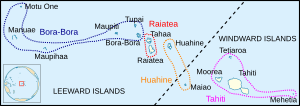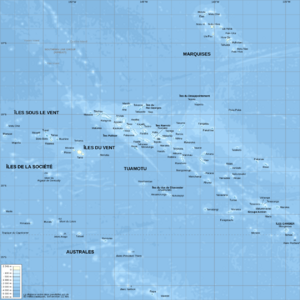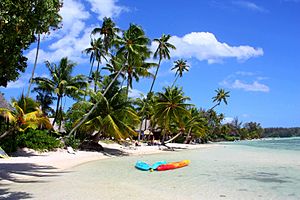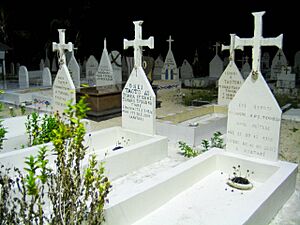French Polynesia facts for kids
Quick facts for kids
French Polynesia
|
|
|---|---|
|
Motto:
|
|
|
Anthem: La Marseillaise(official) Ia Ora 'O Tahiti Nui(unofficial)
|
|
 |
|
| Capital | Papeetē |
| Largest city | Fa'a'a |
| Official languages | French |
| Ethnic groups
(1988)
|
|
| Demonym(s) | French Polynesian |
| Government | Dependent territory |
| François Hollande | |
|
• President of French Polynesia
|
Gaston Flosse |
|
• High Commissioner
|
Jean-Pierre Laflaquière |
| Overseas collectivity of France | |
| 1842 | |
|
• Overseas territory
|
1946 |
|
• Overseas collectivity
|
2003 |
| Area | |
|
• Total
|
4,167 km2 (1,609 sq mi) (173rd) |
|
• Water (%)
|
12 |
| Population | |
|
• Jan 2010 estimate
|
267,000 (177th) |
|
• Aug 2007 census
|
259,596 (177th) |
|
• Density
|
63/km2 (163.2/sq mi) (130th) |
| GDP (nominal) | 2006 estimate |
|
• Total
|
US$5.65 billion (not ranked) |
|
• Per capita
|
US$21,999 (not ranked) |
| Currency | CFP franc (XPF) |
| Time zone | UTC-10, −9:30, -9 |
| Driving side | right |
| Calling code | +689 |
| ISO 3166 code | PF |
| Internet TLD | .pf |
|
|
French Polynesia is a group of islands that are part of France. It is located in the South Pacific Ocean. This area includes 118 islands and atolls spread out over more than 2,000 kilometres (1,200 mi) of water. The total land area is about 4,167 square kilometres (1,609 sq mi).
French Polynesia is divided into 5 main groups of islands: the Society Islands (which include the Windward and Leeward Islands), the Tuamotu Archipelago, the Gambier Islands, the Marquesas Islands, and the Austral Islands. Out of 118 islands, 67 are home to people. Tahiti, located in the Society Islands, is the most populated island. It is also where the capital city, Pape'ete, is found.
After the Great Polynesian Migration, European explorers started visiting these islands. In 1842, France took control and created a French protectorate. This meant France protected and partly controlled the islands. In 1946, the islands became an overseas territory of France, and Polynesians gained the right to vote. The name was changed to French Polynesia in 1957. Since 2003, it has been an overseas collectivity of France. This means it has more self-rule, like its own president.
Contents
Exploring French Polynesia's Past
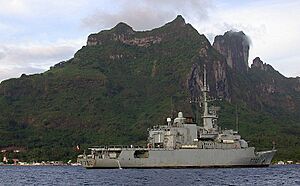
French Polynesia was one of the last places on Earth to be settled by humans. Scientists believe the Austronesian people began the Great Polynesian Migration around 1500 BC. They used the stars to navigate and find islands in the South Pacific. The first islands settled were the Marquesas Islands around 200 BC. Later, Polynesians discovered the Society Islands around AD 300.
Europeans first arrived in 1521. Portuguese explorer Ferdinand Magellan saw Puka-Puka in the Tuāmotu-Gambier Archipelago. In 1772, Dutchman Jakob Roggeveen found Bora Bora.
British explorer Samuel Wallis visited Tahiti in 1767. French explorer Louis Antoine de Bougainville came to Tahiti in 1768. British explorer James Cook visited in 1769. In 1772, the Spanish sent expeditions to Tahiti. A short-lived Spanish settlement was created in 1774. Christian missionaries, both Spanish Catholic and British Protestant, began arriving in the late 1700s.
King Pōmare II of Tahiti became a Protestant in 1812. French Catholic missionaries arrived in 1834. Their removal in 1836 led France to send a warship in 1838. In 1842, Tahiti and Tahuata became a French protectorate. The capital, Papeetē, was founded in 1843. In 1880, France fully took over Tahiti, making it a colony. The island groups were officially united under French protection in 1889.
In the 1880s, France also claimed the Tuamotu Archipelago and the Marquesas Islands. In 1885, France appointed a governor and set up a council to manage the colony. The islands of Rimatara and Rūrutu were annexed by France in 1889. The colony was first called Établissements de l'Océanie. In 1903, its name changed to Établissements Français de l'Océanie.
In 1940, French Polynesia supported the Free French Forces during World War II. Many Polynesians served in the war. After the war, in 1946, Polynesians became French citizens. The islands' status changed to an overseas territory. In 1957, the name became Polynésie Française (French Polynesia). From 1962, the Moruroa atoll in the Tuamotu Archipelago was used for nuclear testing. These tests moved underground after 1974.
In 1977, French Polynesia gained some self-rule, which was expanded in 1984. In 2003, it became a full overseas collectivity of France. In 1995, France resumed nuclear testing at Fangataufa atoll, which caused protests. The last test was in January 1996. France then announced it would stop nuclear weapons tests.
How French Polynesia Works with France
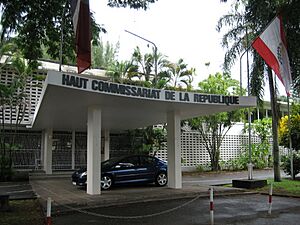
French Polynesia has its own local assembly and government. However, it is not fully independent from France. As a French overseas collectivity, the local government does not handle justice, university education, security, or defense.
These services are managed directly by the Government of France. This includes the Gendarmerie (police force) and the French military. The local government does control primary and secondary education, health, town planning, and the environment. The highest representative of France in the territory is the High Commissioner of the Republic in French Polynesia.
Government and Status
Between 1946 and 2003, French Polynesia was an overseas territory (territoire d'outre-mer). In 2003, it became an overseas collectivity (collectivité d'outre-mer). A law from 2004 also calls it an "overseas country inside the Republic." This gives it special powers but doesn't change its legal status as an overseas collectivity.
Geography of the Islands
The islands of French Polynesia cover a total land area of about 3,521 square kilometres (1,359 sq mi). They are spread out over more than 2,000 kilometres (1,200 mi) of ocean. There are 118 islands in total. The highest point is Mount Orohena on the island of Tahiti.
The islands are grouped into 5 main areas:
- Marquesas Islands
- Society Islands
- Tuamotu Archipelago
- Gambier Islands (sometimes seen as part of Tuamotu)
- Austral Islands
- Bass Islands (often seen as part of the Austral Islands)
Besides Tahiti, other important islands and groups include Ahē, Bora Bora, Hiva 'Oa, Huahine, Mai'ao, Maupiti, Meheti'a, Mo'orea, Nuku Hiva, Raiatea, Taha'a, Tetiaroa, Tupua'i, and Tūpai.
| Commune | Island | Population (2012) |
|---|---|---|
| Fa'a'ā | Tahiti | 29,687 |
| Punaauia | Tahiti | 27,613 |
| Pape'ete | Tahiti | 25,769 |
Economy and Jobs
French Polynesia has a fairly developed economy. It relies on goods brought in from other countries, tourism, and financial help from mainland France. There are good tourist facilities on the main islands. Also, the noni fruit, known for its medicinal uses, provides jobs in agriculture.
The money used in French Polynesia is the CFP Franc.
Main agricultural products include coconuts, vanilla, vegetables, and fruits. Natural resources found here are timber, fish, and cobalt.
In 2008, French Polynesia imported goods worth 2.2 billion US dollars. Its exports were 0.2 billion US dollars. The most important export is the famous black Tahitian pearls. These made up 55% of all exports in 2008.
People and Culture

In August 2012, the total population of French Polynesia was 268,270 people. About 68.5% of these people lived on the island of Tahiti. The capital city, Pape'ete, had 133,627 residents in 2012.
According to the 2007 census, most people (87.3%) living in French Polynesia were born there. About 9.3% were born in metropolitan France. The rest were born in other French overseas areas or foreign countries. The 1988 census showed that 66.5% of people were Polynesian. About 11.9% were Europeans (mostly French). There were also people of mixed French and Polynesian descent, called Demis (9.3%), and East Asians (4.7%), mainly Chinese.
Chinese, Demis, and white people mostly live on Tahiti, especially in the Papeetē area.
Languages Spoken
French is the only official language in French Polynesia. A law from 1996 states that "French is the official language, but Tahitian and other Polynesian languages can be used." In 2007, 68.5% of people aged 15 and older spoke French most often at home. About 24.2% spoke Tahitian. Smaller numbers spoke Marquesan, Tuamotuan, Austral languages, or Chinese dialects.
Most people (94.7%) aged 15 or older could speak, read, and write French. Also, 86.4% of people knew at least one Polynesian language.
Religions Practiced
Christianity is the main religion in the islands. Most people (54%) belong to different Protestant churches. A large group (30%) are Roman Catholic. More than half of French Polynesia's population belongs to the Maói Protestant Church. As of 2012, The Church of Jesus Christ of Latter-day Saints had 21,884 members. In 2014, there were about 3,000 Jehovah's Witnesses in Tahiti.
Images for kids
-
A two-franc World War II emergency-issue banknote (1943), printed in Papeete, and depicting the outline of Tahiti on the reverse
-
High Commission of the French Fifth Republic
-
Bora Bora, Leeward Islands
-
Painting of Two Women of Tahiti by Paul Gauguin
See also
 In Spanish: Polinesia Francesa para niños
In Spanish: Polinesia Francesa para niños




